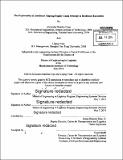| dc.contributor.advisor | James Blayney Rice, Jr. | en_US |
| dc.contributor.author | Cope, Alexander Randon | en_US |
| dc.contributor.author | Yuan, Liqing | en_US |
| dc.contributor.other | Massachusetts Institute of Technology. Engineering Systems Division. | en_US |
| dc.date.accessioned | 2015-01-05T20:00:46Z | |
| dc.date.available | 2015-01-05T20:00:46Z | |
| dc.date.copyright | 2014 | en_US |
| dc.date.issued | 2014 | en_US |
| dc.identifier.uri | http://hdl.handle.net/1721.1/92638 | |
| dc.description | Thesis: M. Eng. in Logistics, Massachusetts Institute of Technology, Engineering Systems Division, 2014. | en_US |
| dc.description | Cataloged from PDF version of thesis. | en_US |
| dc.description | Includes bibliographical references (pages 57-58). | en_US |
| dc.description.abstract | This research aims to characterize and measure hierarchical, functional and geographical alignment within an organization in an effort to understand the individual's attributes of resilience within the broader organization's business strategy. In partnership with a multinational chemicals manufacturer, data was collected from product supply organizations through interviews, surveys and case discussions, in an effort to understand resilience awareness and strategic alignment. The results are primarily used to quantify differences between strategic direction set by executives and the tactical execution of individual contributors. Secondary analysis examines correlations in responses, and further compares results by segmenting respondents by level within the organization, tenure with the company, functional role and cultural background. Data collected through this study identifies a difference between the attitudes and perceptions of executives and those of individual contributors. Understanding this misalignment is important as external research has found that there can be a permanent market capitalization loss of 5-10% after an announcement of a major supply disruption. Whether the disruption is due to a geological event or a political uprising, being prepared to respond to such disruptions is critical in today's complex business environment. Corporate culture, strategy, and people are the fundamental building blocks to ensuring alignment across all levels of an organization, enabling a unified, systematic and effective approach when responding to supply disruptions. | en_US |
| dc.description.statementofresponsibility | by Alexander Randon Cope and Liqing Yuan. | en_US |
| dc.format.extent | 72 pages | en_US |
| dc.language.iso | eng | en_US |
| dc.publisher | Massachusetts Institute of Technology | en_US |
| dc.rights | M.I.T. theses are protected by copyright. They may be viewed from this source for any purpose, but reproduction or distribution in any format is prohibited without written permission. See provided URL for inquiries about permission. | en_US |
| dc.rights.uri | http://dspace.mit.edu/handle/1721.1/7582 | en_US |
| dc.subject | Engineering Systems Division. | en_US |
| dc.title | The exploration of attributes aligning supply chain strategy & resilience execution | en_US |
| dc.type | Thesis | en_US |
| dc.description.degree | M. Eng. in Logistics | en_US |
| dc.contributor.department | Massachusetts Institute of Technology. Engineering Systems Division | |
| dc.identifier.oclc | 898124558 | en_US |
